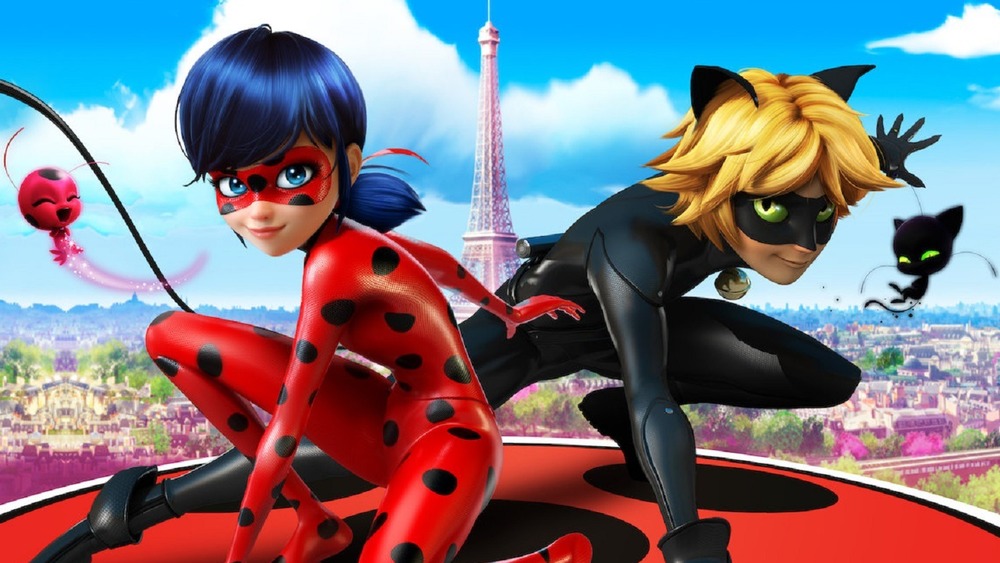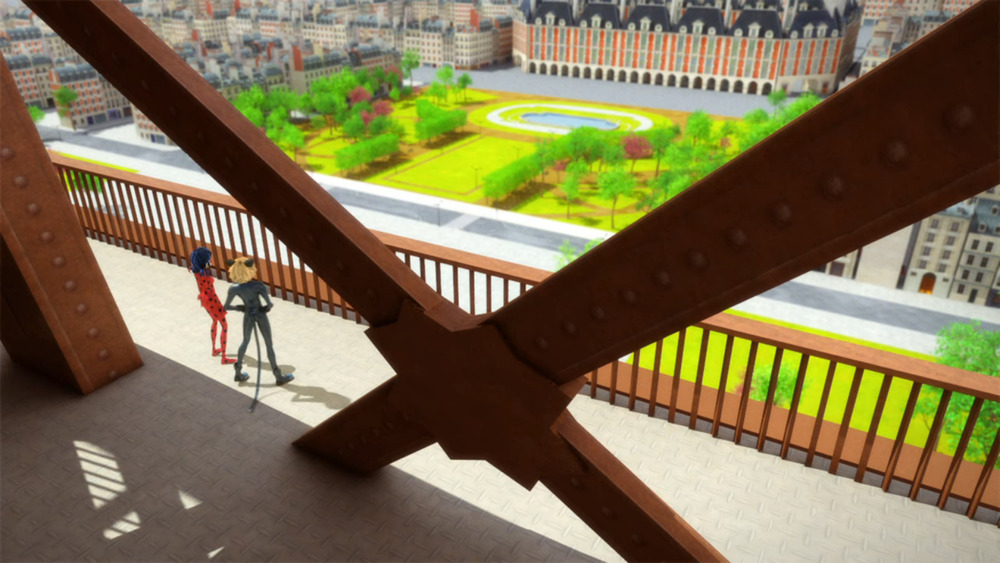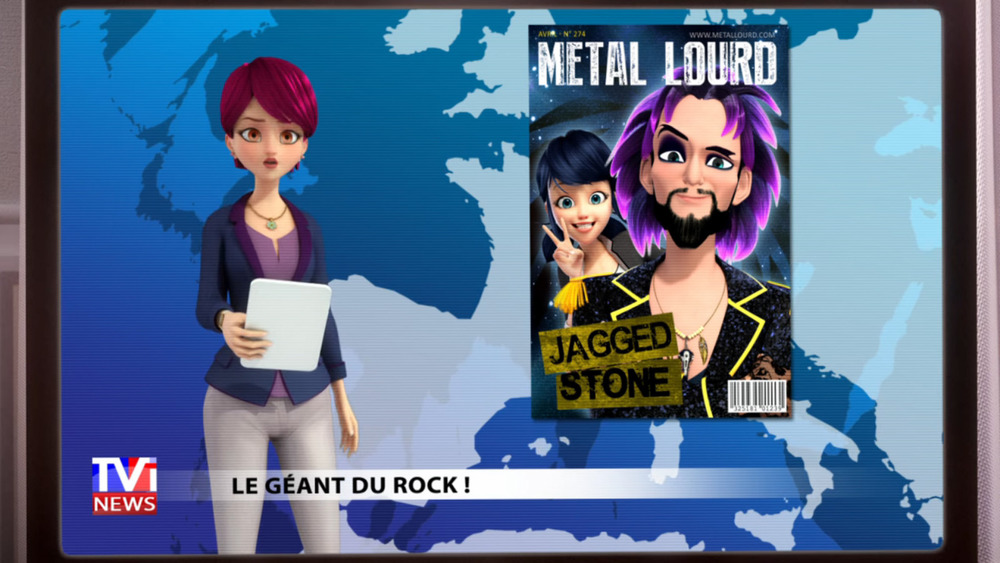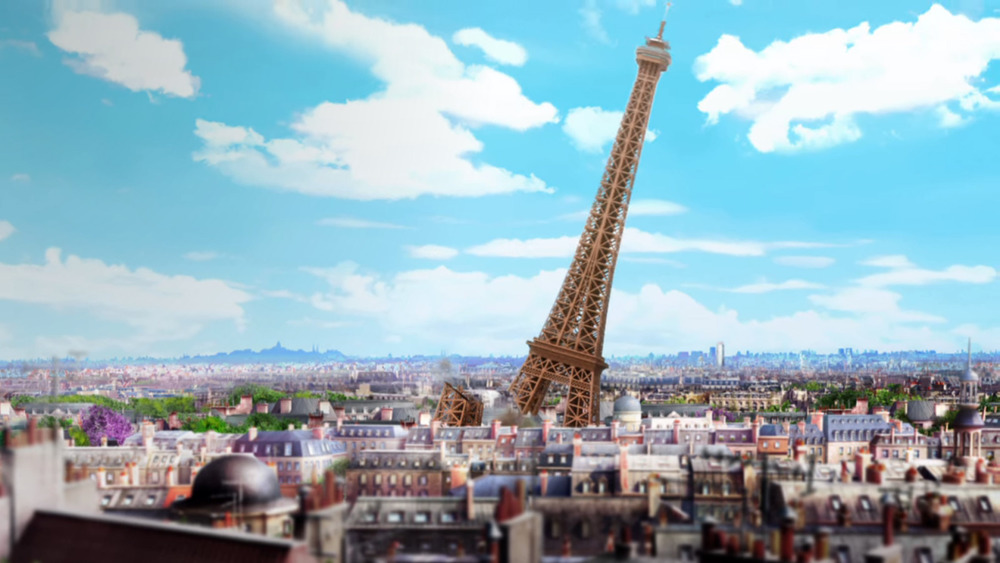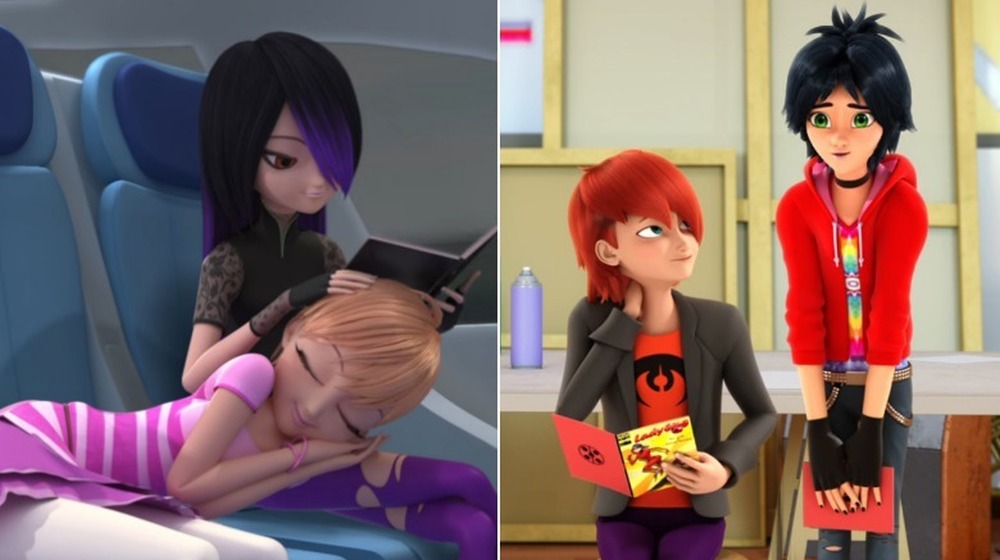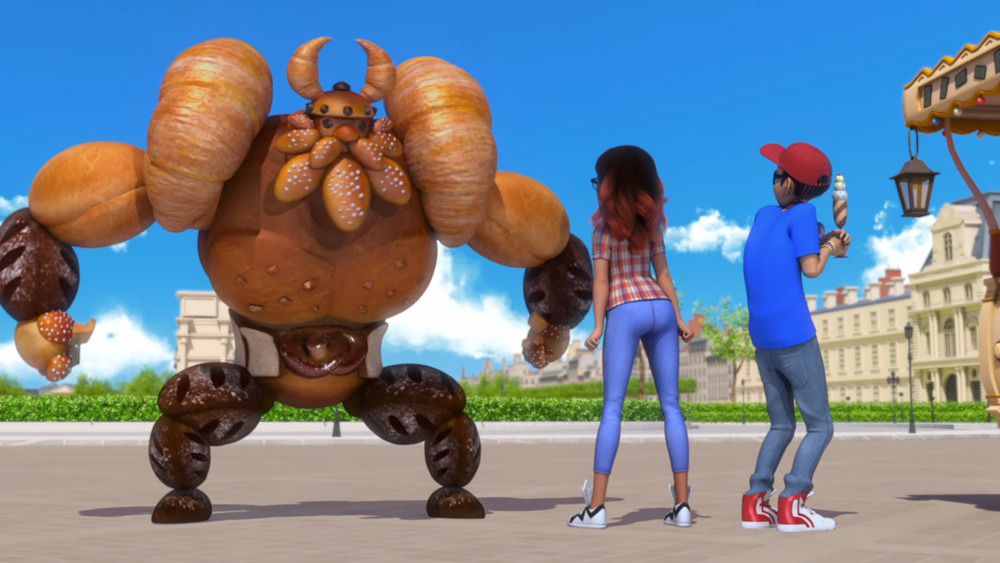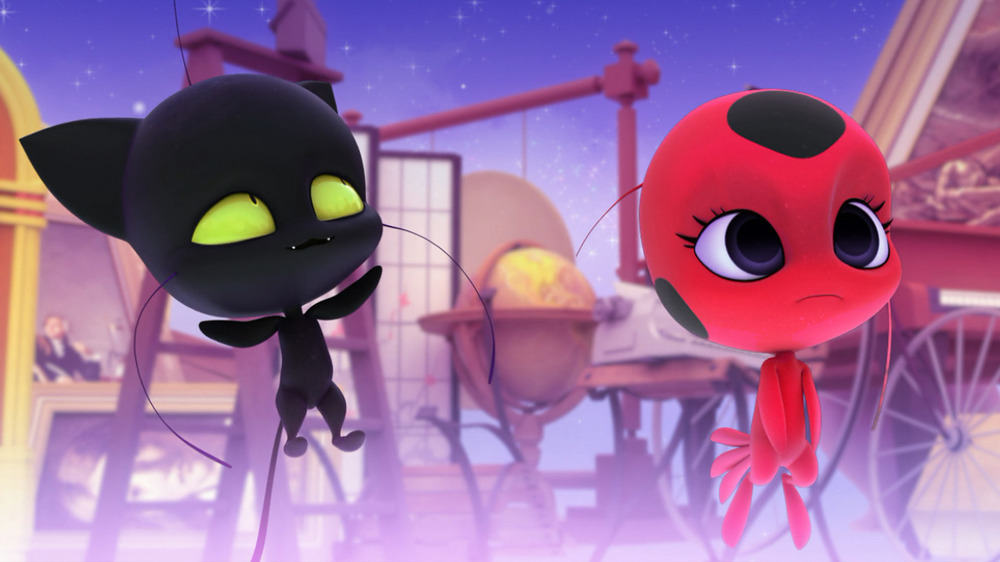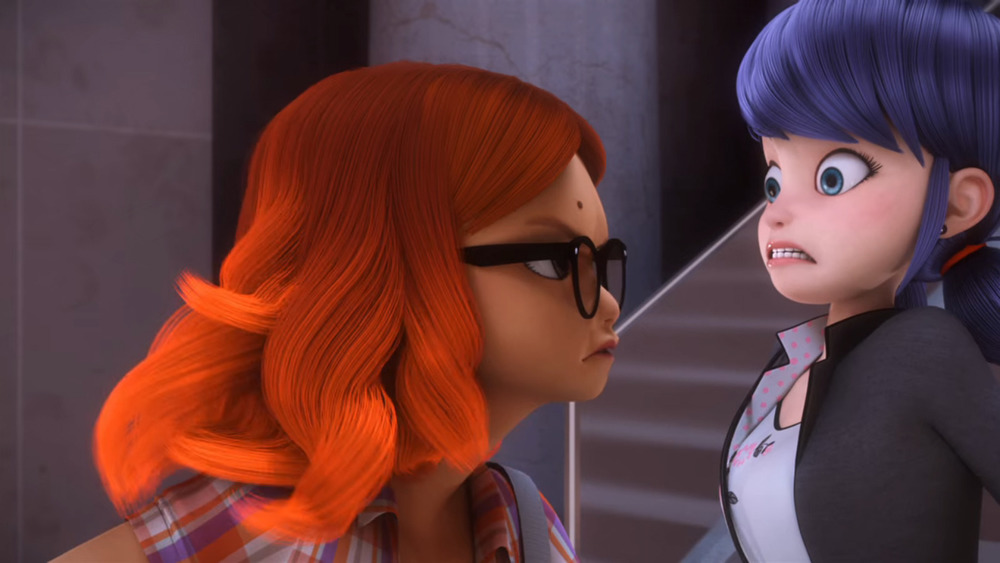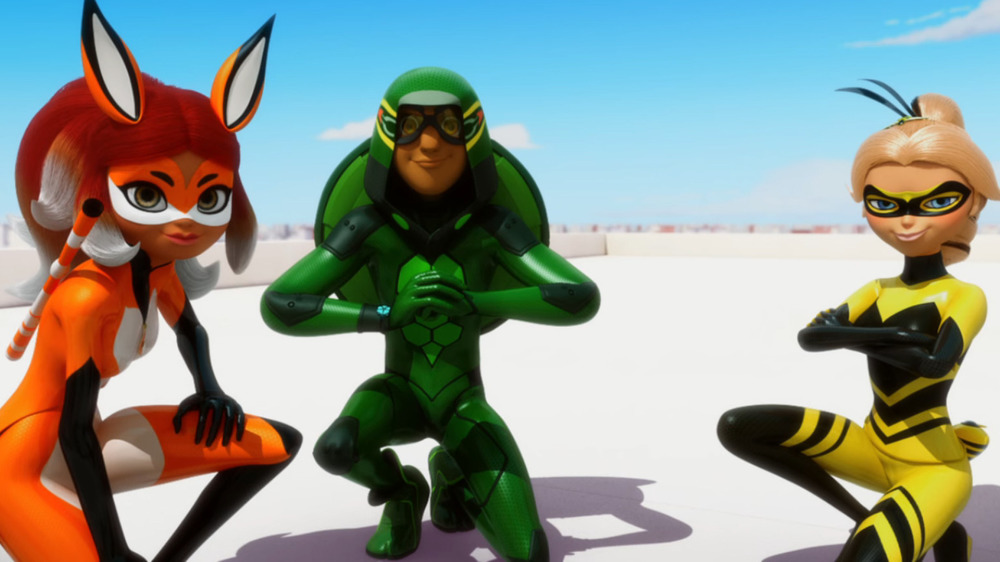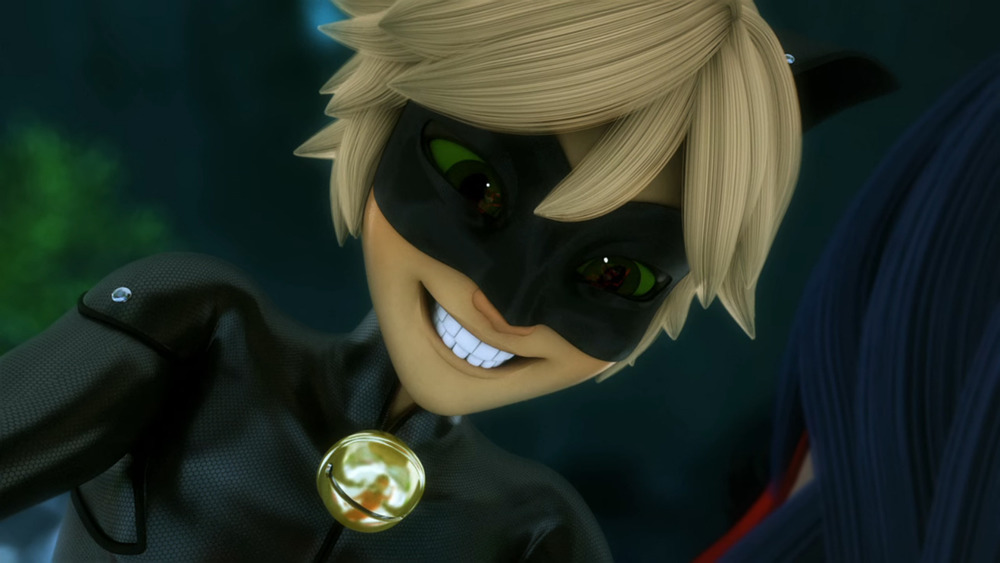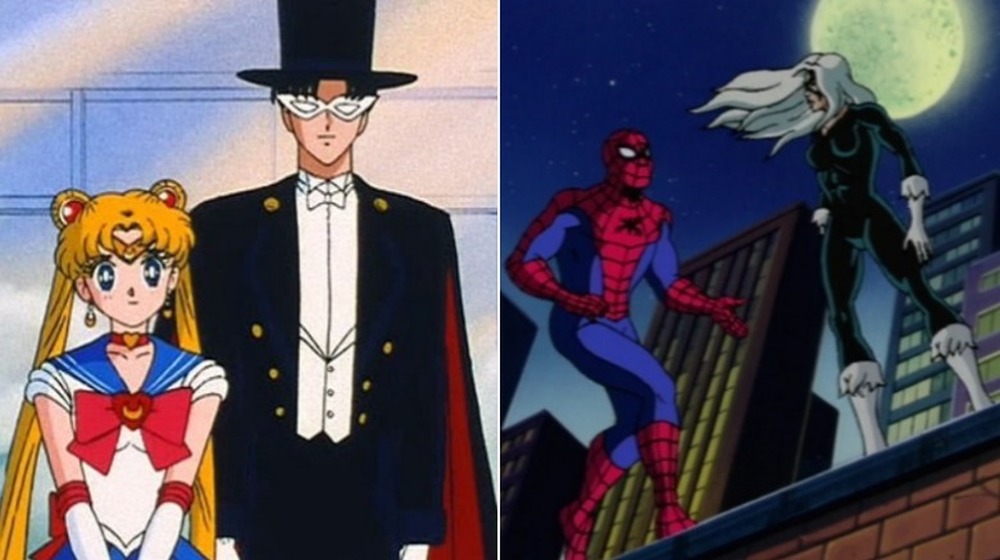Things Only Adults Notice In Miraculous: Tales Of Ladybug And Cat Noir
By day, shy teenager Marinette Dupain-Cheng has a secret crush on the dreamy Adrien Agreste, but he's barely even aware of her existence. By night, Marinette fights crime as the cool and confident superhero Ladybug, alongside her sidekick, the thoroughly awkward Cat Noir. Cat Noir has a not-so-secret crush on Ladybug, but she's not interested in that goober. Besides, her heart belongs to Adrien. But little does Marinette know that Adrien also has a secret — he is Cat Noir.
That's the premise of the French TV series Miraculous: Tales of Ladybug and Cat Noir, a story for helpless romantics of all ages. And while it's clearly written for young kids, Miraculous has a surprising amount of hidden depth for geeky adults to dig into. There's an enormously complex mythology surrounding the Miraculouses, the items that give our heroes their powers, the kwamis, the magical guardians of these items, and the villainous Hawk Moth, who can transform the normal citizens of Paris into powerful supervillains through the use of his magic akumas.
As a result, there are things only adults notice in Miraculous, and we're here to analyze and critique all the little details in this show that you're probably not supposed to think about too much. After all, Miraculous is about feelings, not logic. It asks you to turn off your brain and enjoy the ride. But we can't do that because we're adults now, so we're gonna turn our brains on and start thinking about Miraculous way too hard.
Paris is weirdly empty in Miraculous
Imagine the streets of Paris on a sunny afternoon. What comes to mind? Probably roadside cafés, charming little boutiques, and tree-lined walkways. The highly idealized and colorful version of Paris that we see in Miraculous does indeed have all of these things, but there's also one detail that's consistently missing — people.
Whenever Miraculous features an outdoor scene on the streets of Paris, our main characters are often the only people around, walking down totally empty sidewalks, with only the occasional car passing by in the background. We assume the main reason behind this is most likely a technical one. It would take an enormous amount of time and money to model and animate a hundred bystanders whenever the characters go outside. That being said, the end result of this is that the version of Paris we get in this show ends up feeling totally devoid of life, almost post-apocalyptic.
Contributing even more to the feeling that not that many people live in Paris is the show's remarkably consistent cast of minor recurring characters. Rather than rescuing total strangers each week from the forces of Hawk Moth, Ladybug ends up coincidentally crossing paths with the same characters over and over again, like rock star Jagged Stone, newscaster Nadja Chamack, and mayor André Bourgeois. Not that we mind seeing these same characters all the time, but it just provides more evidence that the Paris of this world has a only a few dozen inhabitants and is otherwise totally empty.
Marinette is just as famous as Adrien
In many ways, Marinette and Adrien are presented as total opposites. Adrien is popular and famous due to his renowned father and his own career as an aspiring model. Marinette, on the other hand, is supposedly a total nobody, sitting at the absolute bottom of the high school hierarchy. But here's the dirty little secret that the show tries to hide from you. Marinette is also extremely popular, just as beloved by her peers as Adrien, and perhaps even equally famous, as well.
Marinette's secret rise to stardom is mainly due to the events of the episode "Pixelator." In this episode, Marinette ends up befriending the world-famous rock star Jagged Stone. And this isn't just a passing acquaintance, either. In a later episode, Jagged asks Marinette to design the cover to one of his albums, which ends up becoming a chart-topping bestseller. She even appears on magazine covers and on television because of this. If that's not enough, Marinette's best friend is a popular blogger, she babysits the child of a famous newscaster, and she's even the granddaughter of the world's most famous chef.
If you're paying close attention, you'll see that even within her own peer group, Marinette is a total social butterfly. As early as the show's fourth episode, we learn that her entire class is overjoyed to see her when she arrives to hang out after school, and Adrien even winks at her. Despite Marinette's continued insistence that she's just a klutzy loser who has zero chance with Adrien, if you actually pay attention to the events of the show, you'll see that all of Marinette's supposed "unpopularity" only exists within her head.
The Eiffel Tower gets destroyed a lot
Without a doubt, Ladybug's most impressive superpower involves her Miraculous Ladybugs. Whenever our hero defeats one of Hawk Moth's creations and purifies their akuma, she unleashes a swarm of magic ladybugs that repair all of the negative effects caused by that villain's superpowers. Because of this handy plot device, the entire city of Paris can get completely trashed on a weekly basis, and as long as Ladybug defeats the monster of the week, we know that everything will be okay.
But if you haven't noticed, there's one particular iconic Parisian landmark that the show loves to destroy whenever it gets the chance — the Eiffel Tower. This famous monument has been demolished countless times across the show's history, so we won't name them all, but let's run down some of our favorites.
The tower is first destroyed in episode 13, when the Mime cuts it in half with an enormous invisible sword. The kaiju-sized baby Gigantitan also knocks the Eiffel Tower over while he's having a temper tantrum. The Collector — Gabriel Agreste's akumatized form — even steals the tower and puts it into his magic book. And in the episode "Style Queen," it isn't even a villain that destroys the tower. Instead, Cat Noir's kwami, Plagg, topples it himself with his "cataclysm" ability.
So while younger viewers might not even notice how poorly this show treats the Eiffel Tower, if you're an adult fan of the show, we recommend making this a drinking game.
An ocean of queer subtext lies beneath Miraculous' surface
Though queer representation in kids' shows is now becoming more of the norm in America, it seems as though France might be a step behind in this regard because there aren't any confirmed LGBTQ+ characters in Miraculous, at least not in the canonical text of the show. In the subtext, however, it's a completely different story. Miraculous contains multiple minor supporting characters who are pretty clearly intended to be in same-sex relationships, even if the show doesn't ever come out and say so explicitly.
The first major gay relationship in the show is between shy goth Juleka Couffaine and bubbly blonde Rose Lavillant. Though polar opposites in many ways, the two characters are clearly very close. They're often shown holding hands, leaning on or comforting each other, and the two are even implied to kiss in the episodes "Zombizou" and "Reflekdoll," though it's somewhat obscured both times.
The other subtextually queer pairing in Miraculous is the one between Marc Anciel and Nathaniel Kurtzberg. These two artsy kids are practically inseparable, and Marc is undeniably designed to be read as queer. Not only does he have visible makeup, rainbow clothing, and queer-coded mannerisms, even his name, Marc Anciel, is a pun on the French term for rainbow, "arc-en-ciel." Series creator Thomas Astruc even semi-confirmed Mark's queerness when he revealed that the character was based on a friend of his, the bisexual genderfluid artist Hope Morphin.
Some of the humor in Miraculous doesn't translate
Although Miraculous is a show that's very much intended for an international audience, some of the jokes still end up being extremely French. And in these cases, younger audience members from the English-speaking world might not understand exactly what they mean.
The most common place that this pops up is with characters whose names are puns in the French languages. For instance, Alya's foxy superhero persona, Rena Rouge, is based on the phrase "renarde rouge," meaning red fox. And the bread-themed villain Bakerix is a riff on the popular French comics character Asterix.
Beyond just puns, Miraculous will sometimes also include jokes that require specific knowledge of French culture in order to be understood, like in the episode "Cat Blanc," where Marinette wants to buy a gift for Adrien's "fifth name's day." Confused? We'll break that one down for you. In France, most common names have a corresponding day of the year, a practice which grew out of the Catholic tradition of saints having yearly feast days. So in France, in addition to buying someone a birthday present, you might also get them a name day present.
The joke here is that Adrien apparently has at least five names — his first name and at least four middle names — and that Marinette has such a huge crush on him that she not only knows all five of his names but would also buy him a present for his fifth name day. It's a great joke, but to younger English speaking viewers, it must seem absolutely impenetrable.
The real villains of the show are ... Tikki and Plagg?
Marinette loves Adrien, and Adrien loves Ladybug. If only there was some third party who knew both of their identities, they could just tell our two heroes the nature of this ridiculous predicament they're in, and Adrien and Marinette could finally be together. Oh wait, there totally is. In the episode "The Dark Owl," Tikki learns that Cat Noir is Adrien, and Plagg learns that Marinette is Ladybug, and yet even after this, both kwamis refuse to tell their owners the truth.
To be fair, Plagg states in the episode "Sandboy" that kwamis are unable to say the names of their current owners, but no such prohibition exists against saying the name of another Miraculous holder. After all, Tikki says Adrien's name plenty of times throughout the show, both before and after she learned his secret. Also, in the episode "Cat Blanc," Marinette travels to an alternate future in which the world basically gets destroyed, and in that timeline, she and Cat Noir know each other's identities, but the end of the world isn't directly caused by that knowledge. Our heroes could totally avoid the bad fate of that other timeline by making better decisions.
As proof that this sort of thing can be done, look at Nino and Alya, aka Carapace and Rena Rouge, two Miraculous holders who are also dating. They learn each other's identities at the end of season 2, and everything is just fine. In fact, they can now even provide alibis for each other, making it arguably more difficult for their identities to be revealed to the wider world. Tikki and Plagg are just being jerks. Why do you hate love, you weird little bugs?
It's extremely weird that no one recognizes Ladybug and Cat Noir
We know it's a minor detail to fixate on, and yet the one thing that our party pooper adult brains can't shut up about as we watch this show is why nobody has figured out the secret identities of Ladybug and Cat Noir. Much like Green Lantern or the Incredibles, Ladybug and Cat Noir have opted for a ... "minimalist" approach when it comes to their disguises. Yes, we know that those tiny little domino masks are just a part of superhero fiction, and we would totally be willing to accept that, but the show just won't stop rubbing our faces it in. In the episode "The Pharaoh," Alya finds Ladybug's history book and thus realizes that the superhero has to be one of her classmates. Once you get to that point, how hard is it to put those final pieces together? Alya, apart from your best friend, are there really that many other girls with bluish-black hair in twin pigtails in your grade level?
There's even a popular fan theory that offers a potential fix to this problem. What if when our heroes transform, they become surrounded by a magic aura that makes it literally impossible for the people they know to recognize them. That means if you were one of Marinette's friends and you saw Ladybug, you'd still be able to see all of her facial features, but you'd suffer from a sort of acute face blindness that would prevent you from connecting these features to someone you know. It's a cool theory, and we'd love it if the series confirmed it one day, largely so that we could get over this distracting obsession and just get back to enjoying the show.
After the first two transformation phrases, someone clearly ran out ideas
If you're a superhero who magically transforms into your alter ego, there's something important that you need to decide ASAP, right up there with your costume and your name — your transformation phrase. Whether you settle on "shazam," "henshin," or "by the power of Grayskull," a good catchphrase is paramount. Ladybug and Cat Noir definitely have this covered. Ladybug's "Tikki, spots on" and Cat Noir's "Plagg, claws out" are right up there with "it's morphin' time" when it comes to top-tier mantras. They're short, punchy, and memorable.
Unfortunately, it's pretty clear that the writers — or perhaps just the translators — quickly ran out of steam after coming up with these first two catchphrases because pretty much every other Miraculous holder we meet has a transformation phrase that's either extremely wordy, nonsensical, or both. Viperion is stuck with the awkward tongue twister "Sass, scales, slither," and Multimouse has the cringe-inducing "Mullo, get squeaky." Just try saying one of those out loud with a straight face, we dare you. Perhaps even worse, Carapace has "Wayzz, shell on" and Queen Bee has "Pollen, buzz on," both of which are basically just copies of Ladybug's phrase.
When you move over to the villains, things don't get better. Mayura has the somewhat wordy "Duusu, spread my feathers," and Hawk Moth has the equally overwritten "Nooroo, dark wings rise." It's possible that all these phrases sound absolutely gorgeous in French, and there's an enormous amount of subtle wordplay going on here that's sailing over all our heads. But from where we're sitting, we think that pretty much all the transformation phrases, with the exception of our two leads, could've used another round of edits.
Cat Noir's crush is pretty creepy
There's a big problem at the heart of Miraculous. You see, the romantic tension between Marinette and Adrien is arguably the most compelling part of the show. We want to root for this relationship to happen, and most of the time, we can. But every once in a while, Adrien crosses a line. To be frank, despite the show's attempts to frame Adrien's crush on Ladybug as sweet and endearing, he sometimes exhibits obsessive, borderline stalker-ish attitudes and behaviors.
When he's acting as Cat Noir, Adrien repeatedly professes his love for Ladybug, time and time again, forcing her to endlessly rebuff his affections, and he sometimes even does this in the middle of their battles against supervillains. There's even a bit in the episode "Animan" when he tries to stealthily smell her without her noticing. As you might imagine, she does notice, and she isn't too pleased. Since he's just a teenager, we're willing to cut the kid some slack, but enough is enough. Seriously dude, don't keep hitting on someone who's already shot you down, especially not while they're at work.
On the other hand, there was that time in the episode "Cat Blanc" when Marinette was sneaking through Adrien's bedroom while he wasn't home, and she touched all his belongings and smelled his pillow, so maybe turnabout is fair play? Eh, you decide for yourself. Is Adrien unforgivably creepy, or do these two freaks absolutely deserve each other?
Miraculous has many parallels to superheroes of previous generations
Like many superhero stories, Miraculous draws heavy inspiration from older TV shows and comic books, and it makes no attempts to hide these influences. However, two of the more obvious influences on Miraculous might be from so long ago at this point that some of the smaller kids in the audience might not recognize them. Oh dear, we're getting old, aren't we?
The first obvious precursor to Miraculous is Sailor Moon. Sailor Moon prominently features a romance between a teenage superheroine, the eponymous Sailor Moon, and a masked mystery man who serves as her sidekick, Tuxedo Mask. Also, both Ladybug and Sailor Moon transform into their superhero costumes through the use of magic items, and both have talking animal sidekicks.
Another famous superhero with many remarkable similarities to Ladybug is, strangely enough, Spider-Man. Both Peter Parker and Marinette are teenagers in red bug costumes. Plus, they both display super agility and a preference for travel by swinging — through the use of web shooters and a magic yoyo, respectively. Just like Marinette, Peter is constantly forced to balance the needs of his personal life with his superhero life, and although Spidey's primarily romantic interest in most of his incarnations is Mary Jane, he also sometimes has a bit of a will they/won't they relationship with a cat-themed superhero of his own. She even has the same name as Cat Noir, albeit translated into English — Felicia Hardy, the Black Cat.
